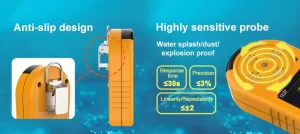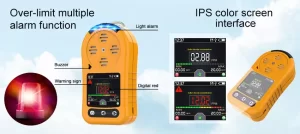Environmental pollution has been a major problem for many years, affecting human health and the ecosystem. The use of gas sensors has revolutionized environmental monitoring, allowing for real-time and accurate detection of pollutants in the air and water. Over the years, technological advancements in gas sensors have led to enhanced sensitivity, selectivity, and portability. This article discusses the latest advancements in gas sensor technology for environmental monitoring.

Gas Sensor Types
There are different types of gas sensors, including electrochemical sensors, optical sensors, and semiconductor sensors. Electrochemical sensors detect gases by measuring changes in electrical conductivity caused by chemical reactions between the gas and the electrode. Optical sensors, on the other hand, detect gases by measuring changes in light absorption or emission. Semiconductor sensors work by detecting changes in electrical resistance caused by the presence of gases. Each sensor type has its advantages and disadvantages, depending on the application.
Recent Advancements in Gas Sensor Technology
Selective Sensing
Recent advancements in gas sensor technology have led to the development of highly selective sensors that can detect specific gas molecules. For instance, researchers have developed a nanocomposite sensor that can detect nitrogen dioxide (NO2) with high selectivity and sensitivity. The sensor is made up of tin oxide nanoparticles decorated with tungsten oxide nanorods. The nanocomposite sensor has a response time of less than 10 seconds and can detect NO2 concentrations as low as 0.1 ppm.
Smart Gas Sensors
Smart gas sensors refer to sensors that can transmit data wirelessly to a central database or cloud storage system. Smart sensors provide real-time monitoring capabilities, enabling quick detection of gas leaks and other environmental hazards. For example, researchers have developed a smart gas sensor for volatile organic compounds (VOCs) that can transmit data wirelessly to the cloud. The sensor uses an array of nanoporous thin films of different materials to detect and quantify VOCs.
Flexible Sensors
Flexible sensors refer to sensors that can bend and conform to any shape, making them ideal for wearable electronics and other flexible devices. Researchers have developed a flexible gas sensor made of a graphene-based nanocomposite that can detect ammonia (NH3) with excellent sensitivity. The sensor can be stretched up to 50% without affecting its performance and can detect NH3 concentrations as low as 10 ppb.
Internet of Things (IoT) Integration
Gas sensors can now be integrated with the Internet of Things (IoT) to enable real-time communication between the sensors and other IoT-enabled devices. This integration allows for remote monitoring of environmental conditions and enables quick identification of environmental hazards. For example, researchers have developed an IoT-based air quality monitoring system that uses a network of gas sensors to monitor the level of air pollutants in urban areas. The system collects data from the sensors and sends it wirelessly to a central database for analysis.
Nanotechnology-Based Gas Sensors
Nanotechnology has led to the development of highly sensitive gas sensors that can detect pollutants at very low concentrations. For instance, researchers have developed a carbon nanotube-based gas sensor that can detect hydrogen gas (H2) with extremely high sensitivity. The sensor uses a single-walled carbon nanotube (SWCNT) functionalized with palladium nanoparticles to detect H2 at concentrations as low as 200 parts per billion (ppb).
Portable Gas Sensors
Advancements in gas sensor technology have also led to the development of portable gas sensors that can be easily carried around. Portable gas sensors are ideal for field work and can be used to detect pollutants in remote areas. For example, researchers have developed a portable gas sensor for ammonia (NH3) that can be attached to a smartphone and used to detect NH3 concentrations in real-time. The sensor uses an array of piezoelectric micromachined ultrasonic transducers (PMUTs) to detect NH3 at concentrations as low as 100 ppb.
Applications of Gas Sensor Technology
Gas sensor technology has numerous applications in environmental monitoring, including air quality monitoring, water quality monitoring, and industrial process monitoring. Gas sensors are also used in health monitoring, food safety, and homeland security. For instance, gas sensors are used to detect harmful gases in industrial settings, such as carbon monoxide (CO) and sulfur dioxide (SO2).

Conclusion
Advancements in gas sensor technology have led to enhanced sensitivity, selectivity, and portability, making them ideal for environmental monitoring. Selective sensing, smart gas sensors, flexible sensors, IoT integration, nanotechnology-based gas sensors, and portable gas sensors are some of the latest advancements in gas sensor technology. Gas sensors have numerous applications in environmental monitoring, health monitoring, food safety, and homeland security. As the need for environmental monitoring continues to grow, gas sensor technology will play an increasingly important role in protecting human health and the ecosystem.
 : +86 155 8830 2704
: +86 155 8830 2704 : jxdziot@gmail.com
: jxdziot@gmail.com
